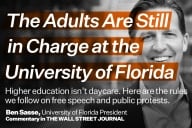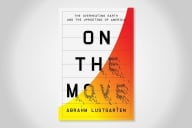You have /5 articles left.
Sign up for a free account or log in.

Why should higher ed people be so interested in Apple’s new big, expensive ($5 billion), round, and un-child care centered headquarters building - Apple Park?
I could not resist reading Steven Levy’s 5/16/17 Wired cover story, One More Thing: Inside Apple’s Insanely Great (Or Just Insane) New Mothership. Could you?
Measuring our academic obsessions is always tricky. Based solely on the convenience sample of my professional network, I feel some degree of confidence in claiming that Apple Park matters to higher ed.
We like to talk about this building.
We have opinions about the design and function of Apple Park, and we seem to want to relate the new headquarters to our own physical campuses and buildings.
Why?
Is it too early to theorize a building that has not yet opened?
Is it too big a stretch to connect Apple Park - the new headquarters of a company with an $800 billion market cap and that is sitting on $67 billion dollars in cash - to our higher ed world?
To deny the emotional payload that Apple Park delivers to higher ed would be - I suspect - to deny reality.
Rather that denying that for some reason this new building seems to matter to us, we should try to figure out why it does.
I have some theories.
Anyone who makes a life in academia is someone who thinks a good deal about the future. The work of educating students and creating knowledge is one of long time horizons. We teach and research today so that the lives of our people and our communities will be better tomorrow. The long history of many of our institutions, (my college is exactly 200 years older than I am), makes this future orientation even more acute. We make decisions in the present that we think will secure and honor an old and long-term legacy. Our values are the opposite of short-termism.
It is this future orientation - a way of thinking that is particularly acute amongst digital learning folks - that perhaps makes Apple Park so interesting.
The building feels like something out of tomorrow. It is not only that Apple Park is a big doughnut. Rather, we get that the future of work is one of collaboration and collision. The Apple building puts as many people as possible on a single level. The entire design is intended to increase opportunities to have unplanned encounters.
The dream of cross-speciality collaboration (interdisciplinarity) is alive and well on postsecondary campuses throughout the land. Perhaps in reaction to the reality of narrower and narrower sub-specialization as the only viable academic career plan, the dream of cross-disciplinary scholarship and teaching has only grown more alluring.
One could imagine populating Apple Park with professors and students - as opposed to designers and developers. What would the academy look like if social and life scientists, humanists and physicists, all were housed within a single round building? Would we find a new kind of higher ed in this new kind of building?
Perhaps Apple Park intrigues because it represents - in so many ways - an anti-vision of higher ed today.
Apple is able to spend $5 billion on a new building while almost all of postsecondary education in the midst of the existential crisis brought on by the cost disease and the age of permanent scarcity.
Through Apple Park, Apple has manifested a single and unified vision. A philosophy made tangible in glass and steal.
Does the higher ed of 2017 have the confidence or the singularity of vision to do anything of this scale?
When it comes to buildings, we worry more about a creeping amenities arms race (those fancy athletic facilities and student residence halls) than how architecture may articulate and advance our vision. Any cost is a cost too high. To spend at the level that Apple has for Apple Park in higher ed would seem immoral, unseemly, and just not all that prudent.
But what do we lose when scarcity is our only mindset?
Is it worrying to us that higher ed has ceded the cultural mindspace - one made real in a new building - to a private company such as Apple?
In the end, we in higher ed may not buy into Apple’s vision of how people should work. We believe more in campuses than buildings. We are getting comfortable with a blended and low-residency (low-campus?) model. And we (hopefully) would not neglect onsite child care.
Our physical campuses need not look like Apple Park, however, for Apple Park to be influential on how we think about higher ed.
What can higher ed do, in this age of a few hyper wealthy tech companies (Apple/Google/Facebook/Microsoft/Amazon come to mind), to make as large a cultural impact as Apple Park?
How would you connect our higher ed world to Apple Park?








